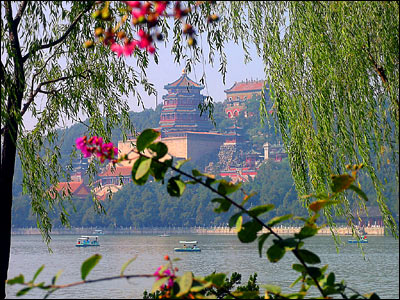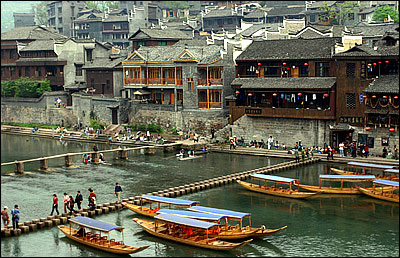| Home / 2006 China in Brief / Tourism | Tools: Save | Print | E-mail | Most Read |
| Tourism Resources |
| Adjust font size: |
In October 2005, Chinese National Geography and 34 media co-evaluated and co-graded "China's most beautiful places." The result was a compilation of over 100 scenic splendors -- divided into 17 types of attraction: mountains, lakes, forests, grasslands, deserts, Danxia landscapes, islands, coastlines, waterfalls, glaciers, gorges, city districts, country towns and villages, show caves, peak forest, Yadan landforms and wetlands. Natural Sites Mount Taishan in the east, Mount Hengshan in the south, Mount Huashan in the west, Mount Hengshan in the north, and Mount Songshan in the center of China have been called the five Sacred Mountains since antiquity. Mount Taishan, in central Shandong Province, is admired by Chinese as paramount among them. Another mountain celebrated for its beauty is Mount Huangshan in southern Anhui Province, known for its graceful pines, grotesque rocks, cloud seas and hot springs. Jiuzhaigou, Huangguoshu Waterfalls, and Guilin are all located in southwestern China. Jiuzhaigou in northern Sichuan Province is a beautiful "fairyland" valley stretching over 40 km and covering a 620 sq km area of snow-capped mountains, lakes, waterfalls, and forests. The Huangguoshu Waterfalls in Guizhou Province is a group of 18 above-ground and four under-ground waterfalls, and can be heard from five km away. The Lijiang River in Guangxi Province has a section of 82 km between Guilin and Yangshuo, which winds its way through karst peaks. On the plateau in northwestern China are many spectacular lakes. The Tianchi (Heavenly Pool) in the Tianshan Mountains in Xinjiang Autonomous Region is 1,980 meters above sea level. This 105-m-deep lake is crystal clear, surrounded by high mountains covered with green grass and colorful flowers. Along the renowned Three Gorges of the Yangtze River are many scenic spots and historical sites. The Qutang Gorge is rugged and majestic. The Wuxia Gorge is elegant, deep and secluded. The Xiling Gorge has many shoals, swift torrents and reefs. The Lesser Three Gorges are lush and green, its water so clear you can see to the bottom. The Three Gorges Dam built here is the biggest key hydropower project in China. Historical and Cultural Sites
China's long history has left many cultural relics and the title of "China Top Tourist City" has gone to the first batch of 205 cities. The Great Wall, a symbol of the Chinese nation, is a prime example of China's historical sites that have become major tourist attractions. As the greatest defense-structure project in the history of human civilization, it dates back more than 2,000 years ago to the Spring and Autumn and the Warring States periods. With its huge scale and incomparable grandeur, it can be called one of the wonders of the world. Today there are 10 sections of the Great Wall open to tourists, including the passes, blockhouses and beacon towers at Badaling in Beijing, Laolongtou and Jiayuguan Pass. Grottoes, cliff paintings and sculpture are also splendid treasures of China's tourism resources. China's grottoes are mostly concentrated along the ancient Silk Road in Gansu Province. The best known is the Mogao Caves, a "treasure house of oriental art" with 492 caves with murals and statues on the cliff face. The total area of the murals is about 45,000 sq m and there are over 2,100 colorful statues, all of high artistry and imagination. In the south, grotto art is represented in Sichuan Province by the Leshan Giant Buddha, carved into a cliff face. At 71 meters high and 28 meters wide, it is the largest sitting Buddha built of stone, and shows the superb carving skills of ancient craftsmen. The Shaolin Temple in Henan Province, the birthplace of Chinese Zen Buddhism, was first built in 495 and is famous for its Shaolin kungfu martial arts. Here one can see the famous Ming Dynasty Five-Hundred-Arhats mural, and the Qing period Shaolin kungfu paintings. In Hubei Province, beautiful Wudang Mountain has 72 grotesque peaks within a radius of 30 km. A sacred site of Taoism, it preserves China's most complete, largest-scale and best ancient Taoist architecture. In western Sichuan Province, Mount Emei, dotted with ancient Buddhist temples and monasteries, is one of China's four holy Buddhist mountains. There are 101 famous historical and cultural cities in China, most of which are over 1,000 years old. To the south of the Yangtze River, Suzhou and Hangzhou, long known as "paradise on earth," are crisscrossed with rivers, lakes, bridges, fields and villages, as beautiful as paintings. Today's well preserved Pingyao Old City in central Shanxi Province was built in the Ming Dynasty but was also a site of Neolithic era Yangshao and Longshan cultures of 5,000-6,000 years ago. The ancient city of Lijiang in Yunnan Province is not only the center of the Naxi minority Dongba culture, but also a meeting point for the cultures of Han, Tibetan, Bai and other ethnic groups. Built in the Song Dynasty, this city has many stone bridges, stone memorial arches and civilian houses which provide precious materials for studying the history of Chinese domestic architecture and can be called a "living museum of ancient civilian houses." Folk Customs and Habits
The diverse cultures and life styles of China's 56 ethnic groups are reflected in their festivals. The biggest Tibetan festival -- Shoton (Yogurt) Festival -- is also the setting for the annual Tibetan Theatrical Festival when, for five days in summer, Tibetan theatrical groups perform and compete in the Norbulingka, the summer palace of the Dalai Lamas. Another summer festival is the Nadam Fair on the Mongolian grasslands where the attractions include wrestling, horse racing and archery contests. March Street is celebrated on Diancang Mountain by the Bai people of Dali, Yunnan Province. It is associated with the Buddhist Goddess of Mercy suppressing a devil to help the Bai people and it became traditional to burn incense and offer sacrifices to commemorate her virtues. The festival has become a major annual gathering for Bai commercial, cultural and sports activities. The Water-Sprinkling Festival of the Dai ethnic group in Xishuangbanna, Yunnan Province, is a lively springtime celebration. People chase and pour water (a symbol of good luck and happiness) over each other, among other activities such as dragon boat racing and peacock dances. Lugu Lake, between Sichuan and Yunnan provinces, has become a tourist destination following the building of a new highway giving access to this area. The matriarchal society of the 30,000 local Mosuo people is noted for its "no marriage" traditions and is called the last women's kingdom on earth. The grace of the Mosuo women, the elegance of their canoes and the undulating singing constitute the "three uniquenesses on the lake." |
| Tools: Save | Print | E-mail | Most Read |
 |
| Related Stories |

